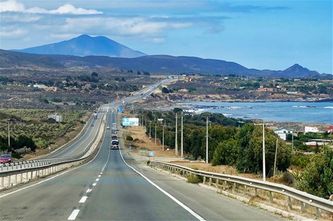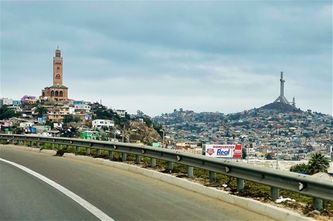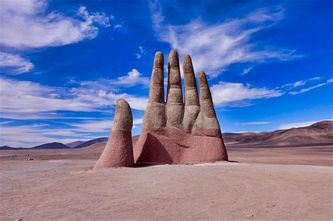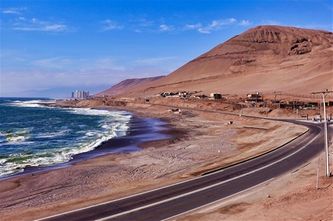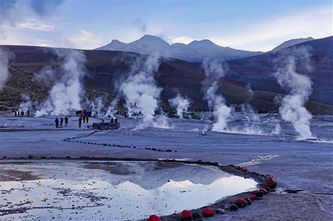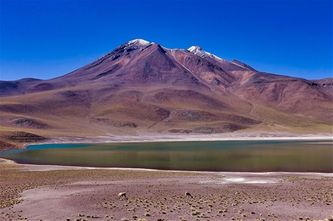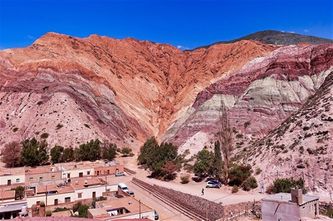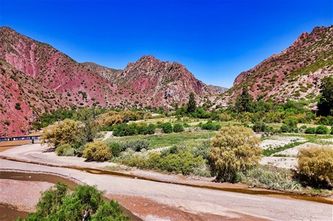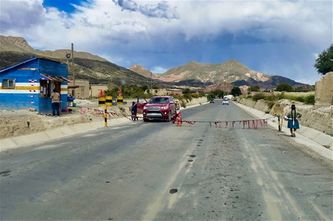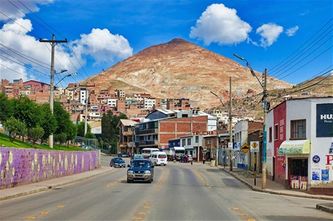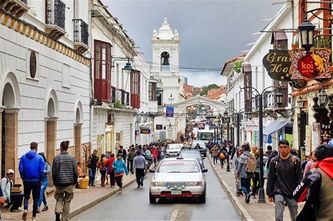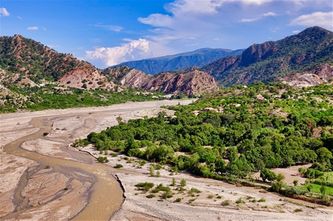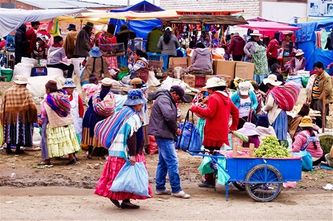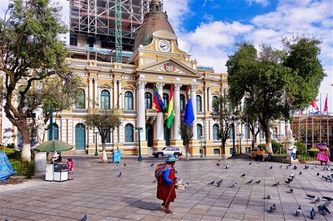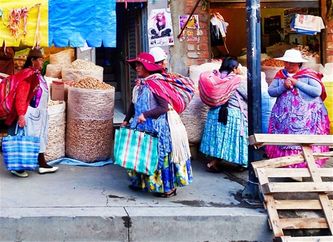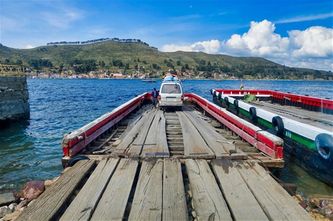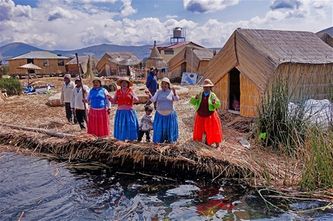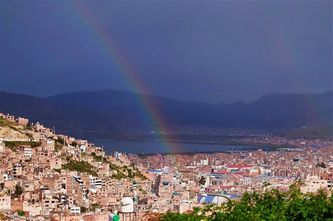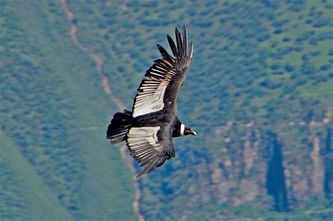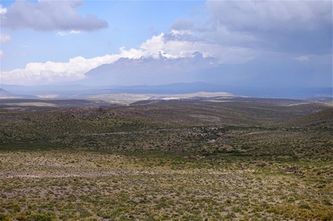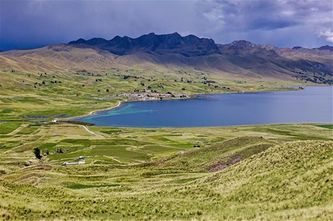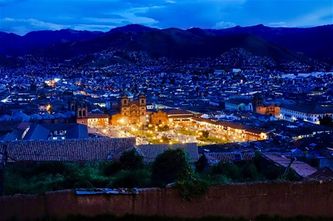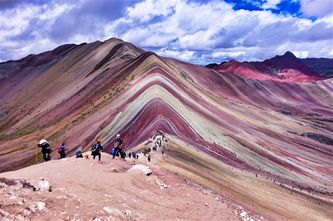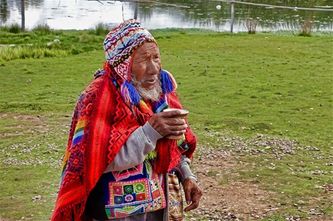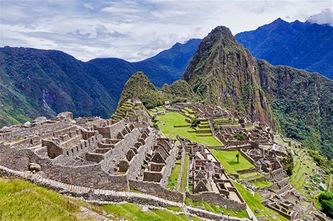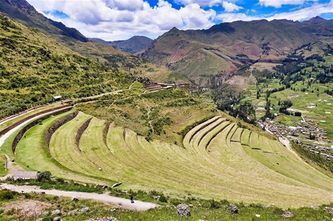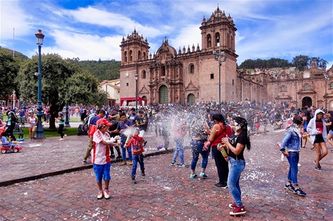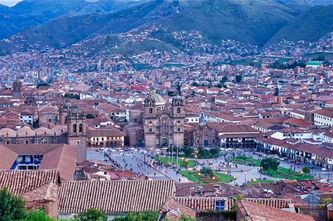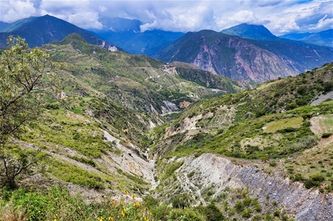Zu alt zum Arbeiten, zu jung zum Sterben, gerade richtig zum Reisen. ...........................................................................Too old to work, too young to die, just right to travel.
March 31, 2019
Today we traveled from Ovalle to Viña del Mar (299 km). Today was a sunny day with blue sky. The road led mostly along the Pacific Ocean (see picture). Just before we reached our destination we wanted to shop some things. The supermarket which was shown in Google Maps was not there. But then we found a big mall with a supermarket where we could find all we needed.
March 30, 2019
Today we traveled from Caldera to Ovalle (505 km). Today many things were different than the days before. First, the sky was covered with clouds. Second, the temperature was never higher than 20 ℃. Third, the more south we came the more vegetation we see. It seems that the climate is different now. And we are now in the fall in the southern hemisphere. We hope we will reach the southernmost point before winter really starts. Today we crossed the first bigger city in Chile, it is La Serena. It is built together with Coquimbo, from which a part is shown in the picture. It seems to be a religious city. A church at the best place and this huge cross on the other hill!
March 29, 2019
Today we traveled from Antofagasta to Caldera (508 km). We drove another day through the desert. By accident, we found the sculpture «Mano del desierto» just some kilometers after Antofagasta on Ruta 5. I saw many pictures of this sculpture but didn't know where it is. We were lucky that we saw it from the road. The road seems to be quite dangerous. We saw almost every 100 meters a memorial for someone how died on this road. And we saw some car wrecks laying on the side of the road. But we had no problems to reach our destination. We found here in Caldera a nice supermarket. Since we didn't see one for some weeks we came in a shopping frenzy. And we found here a big and well equipped and maintained campground. It feels a bit like in the USA. And we did unpack our grill the first time since the USA and grilled our own burgers for dinner. It was just delicious.
March 28, 2019
Today we traveled from San Pedro de Atacama to Antofagasta (338 km). The drive went first through some mountainous and later through desertlike landscapes. In the desert, the sight was hazy. But I remembered that this region has a history. From 1879 until 1884 was here the saltpeter war. This land belonged to Bolivia at that time. Here were large sources of saltpeter which were excavated by Chilean companies. The Bolivians augmented the prices for the excavations against an existing contract with Chile. The Chileans didn't want to pay it and started a war. In the end, Bolivia lost this land with all the minerals. Here are today the biggest copper mine in the world and many more mines which bring Chile a lot of wealth. And Bolivia lost access to the sea. Bolivia paid a high price for its greed. Still today Bolivia is mourning the loss of the access to the sea. Evo Morales went some years ago to The Hague International Institute for Global Justice. He wanted to have back the access to the sea. But the tribunal decided against Bolivia. The picture was made form the campground south of Antofagasta. We are back at the Pacific Ocean. In the distant, there are the first buildings of Antofagasta to see.
March 27, 2019
Today we stayed in San Pedro de Atacama. We got up even earlier as yesterday (4 am). Today we attended a tour to the Geysers at El Tatio. One should see them at dawn. The geyser field at El Tatio is the third largest in the world. The biggest is at Yellowstone in the USA. The second somewhere in Russia. But these geysers emit poisonous gases. Therefore it is difficult to visit them. At El Tatio are about 150 geysers at an elevation of 4200 meters which emit hot water (86 °C) or steam (see picture). Some geysers eject the water up to two meters and the steam clouds are about 20 meters high. It's nice to see these geysers. We were back in San Pedro at noon. We had an afternoon to chill and do some work.
March 26, 2019
Today we stayed in San Pedro de Atacama. We got up early (6 am) because we went on a tour. There is a lake where there are flamingos. Katharina wanted to see these flamingos. We were the first group which was there and we saw some flamingos. But then the flamingos flew further away in order they were almost invisible. Then we drove up to the high plateau at 4100 meters. Here are nice lakes in front of vulcanos (see picture). And there we saw groups of Vincunias a wild kind of lamas. The tour ended at 2.30 pm. We had an afternoon to chill and do some errands.
March 25, 2019
Today we traveled from Humahuaca in Argentina to San Pedro de Atacama in Chile (479 km). The 68 km from Humahuaca to Purmamarca were very nice. On both side of the road were nice mountains with different colors and shapes. The culmination was in Purmamarca. Here is a wonderful and colorful mountain (see picture). From here we traveled on the Paso de Jama. This pass is 411 km long and climbs up to 4800 meters. Our goal was to overnight on the pass. But we were quite fast and reached the border to Chile at about 4 pm. Therefore we decided to drive to San Pedro de Atacama. The border formalities were quite easy. Except that the Chilean did a severe check of our RV. We had to take all our belongings out of our storage room and everything was inspected. But they didn't find anything they had to complain about. It was another 190 km to San Pedro de Atacama. The drive over this pass was wonderful. We had the best weather, a good road and we saw 5 salt flats and many nice mountains. We reached San Pedro at 8 pm in the last light of the day.
March 24, 2019
Today we traveled from Tupiza in Bolivia to Humahuaca in Argentina (251 km). First, we traveled through a mountainous landscape along the Rio Grande (see picture). Some kilometers later the landscape became flat. Here we had to cross the border. Because there were a lot of people traveling from Bolivia to Argentina we needed about an hour to cross the border. All the administrative things worked fine and without problems. And we lost an hour because of the time difference between Bolivia and Argentina. Then we drove for a big part of the way again through flat land. But then it became mountainous again. The mountains had some red color and there were a lot of cacti. It looked again like Arizona.
March 23, 2019
Today after the second safe night in front of the army barracks we traveled from Uyuni to Tupiza. Actually, we wanted to travel from Uyuni directly to Chile. But there is no road which is doable with our RV. Therefore we have to drive a detour through the northern part of Argentina. The drive to Tupiza led through a mountainous landscape. The rocks had different colors. There are different minerals in the ground. Therefore we saw some active and some abundant mines. The picture shows how we have to pay the road toll here. They block the street and you have to go to the blue hut to pay. Then they let you drive further on. We had to drive on gravel roads today for more than 10 kilometers. Even the road on the picture was not perfect.
March 22, 2019
We had a safe night in front of the army barracks. We got waked up by the army music corp at 7.30 am. Today we took a tour to the Salar de Uyuni (Uyuni Salt Flats). This is the biggest salt flat in the world. It is 110 x 120 km large. The salt layer is until 2 meters thick. We just drove a bit out on the salt and spend the whole day with doing different pictures. Before going to the salt flat we visited the train cemetery just outside of Uyuni. There is a train line which connects Uyuni to the Chilean coast. They bring Borax there. These old trains are just put here to die. The picture shows how salt is harvested on the Salar de Uyuni.
March 21, 2019
Today we traveled from Sucre to Uyuni (361 km). The plan for today was to drive to Potosi and overnight here. But when we arrived in Potosi the hotel we chose didn't have rooms. And we couldn't find the parking spaces we had information about. There are very steep and narrow streets in Potosi. It was not easy to drive there with our RV. We decided, therefore, to drive on to Uyuni. Potosi is an interesting place. Here is the biggest silver mine the Spanish opened and from where a lot of the wealth came from. Still today there are mines here and they supply silver and other metals. The Spanish opened here a mint too. I wanted to visit this building which is a museum today. But unfortunately, we were not able to do this. The drive to Uyuni was another 200 km. We drove through nice landscapes and saw thousands of lamas. We reached Uyuni at sunset time. The hotel we had in mind was too expensive for us. We parked in front of a military barracks. We hope the army watches over us and we will spend a nice night here. The picture shows Potosi and the mountain which contained all the silver.
March 20, 2019
Today we had an easy day in Sucre. And we went to visit the old part of the city. Sucre is the second capital of Bolivia. The Supreme Court is located here. Sucre is called the White City. Almost all the buildings are white. Around 5 pm it started to rain again. We went for an early dinner. After dinner, there was no rain anymore. The picture was made on our way back to the campground. There are still dark clouds around. Later ist rained therefore again.
March 19, 2019
Today we traveled from Cochabamba to Sucre (342 km). The road led through hilly landscapes almost all the way. Sometimes it looked like in Arizona with red rocks and cacti. The weather was nice and sunny. The temperature was about 22 °C in Cochabamba. On the way, it climbed up to 38 °C. When we arrived in Sucre it was down to 25 ℃ again. Sucre lays on 2800 meters. In the evening a heavy storm with heavy rain, thunder, and lightning blustered over Sucre. We walked home from dinner in the rain and got quite wet. Then all the lights went out. It took about an hour until the electricity came back. The picture shows one of the landscapes we drove through today.
March 18, 2019
Today we traveled from La Paz to Cochabamba (379 km). First, we had to climb up from the campground at 3300 meters to the high plateau of more than 4000 meters. Then we had to cross a market, which was on both sides of the road (see picture). The traffic was very slow there. Then there was a boring drive on the high plateau for at least 200 km. Then the road went into the mountains. This was a bit more interesting. Just before we reached Cochabamba we drove through a barricade. There were a lot of stones and fires on the road. I don't know what they did protest for or against. But President Evo Morales became big by doing such barricades. Now he wants to change the constitution to be president for a fourth term. There was a vote and the people voted against this change of the constitution. But Evo Morales wants to change it anyway. This could be the reason for the barricade.
March 17, 2019
Today we visited the city of La Paz together with Gerd a German who lives for 37 years in this city. The campground lays in the lowest area of La Paz (3300 meters). Here it is warmer as in the higher areas. Therefore the richer people live here. We drove with a taxi to the nearest station of the teleferic. Today there are many lines of this teleferic connecting all parts of the city. We went to the highest point of the city which is on an altitude of more than 4000 meters. From here there is a wonderful view of the city. Then we went into the center of the city. By the way, the teleferic is made by an Austrian Company and the cars by a Swiss company. We have this kind of transportation in the mountains mostly to go skiing. But here it's a good way to bring the transportation of the people away from the streets, which are crowded all the time. In the center of the city, we saw the government and the parliament buildings and many more places. Gerd was able to explain to us the history of La Paz and Bolivia and the politics in this country. We learned a lot about La Paz and Bolivia.
March 16, 2019
Today we stayed at the campground and had an easy day. We organized a sightseeing tour for tomorrow and organized our travels in Bolivia. I made the attached picture yesterday while we drove through La Paz. Sometimes the traffic stopped and I was able to take some pictures. It shows how the women are dressed in this region.
March 15, 2019
Today we traveled from Puno in Peru to La Paz in Bolivia (286 km). First, we had to cross the border between Peru and Bolivia. Everything went very smooth. We didn't need more than half an hour for it. Then we stopped at Copacabana. We had to get some Bolivian money. That worked out too. Then we went to eat something here because we left Puno without breakfast because we knew that we need a lot of time to reach La Paz. And there is a time difference between Peru and Bolivia of one hour which plays against us too. Then we had to take a ferry to cross an arm of Lake Titicaca (see picture). Later I got my first fine on our Panamerica journey. It was a speed ticket. I drove 100 km/h instead of 80 km/h. I did that all the time until now. But here in Bolivia, the police seems to check better. Then we had to drive through La Paz. The traffic here is very heavy. But we did it without problems. We only needed more time than planned. When we reached our destination it was already dark. It is the camping of Hotel Oberland. It was founded by a Swiss but he sold it last year to someone from Bolivia. Here we met a lot of other travelers and had a nice Swiss dinner.
March 14, 2019
After a safe and quiet night, we went to visit the Uros people. We let our RV in the safe parking of the campground and took a taxi into Puno (13 km). Here we booked a tour to the floating islands of the Uros people. The boat took about half an hour out to these islands. This place is very unique. First, there is Lake Titicaca which is the largest sweet water lake in South Amerika. And it is the highest navigable lake in the world (3810 meters). The Uros people had to flee from some intruders and hid in the reed areas of the lake. The lake is here very shallow (2 - 10 meters deep). Then they started to build floating islands, houses and boats out of the reed. They live from fishing and bird hunting. Nowadays they have some modern things like toilets and showers and produce electricity with solar panels. And the tourists are the most important income. I think to remember that they taught Thor Heyerdahl how to build a boat out of reed. He then crossed the Atlantic Ocean with the Ra II. The Uros people still have some of these boats and use them today to row tourists around. We did go by such a boat from one island to another.
March 13, 2019
Today we traveled from Arequipa to Puno (323 km). The drive went through nice landscapes. The weather changed a lot of times. We had sun, rain, and hail. When we arrived at Puno the rain just stopped and a rainbow was formed over the town and Lake Titicaca (see picture). We just drove through Puno. It seems to be a clean but poor town. We were warned since there were some vans robbed out in Puno. Therefore we didn’t stop in the town. We are about 13 km outside the town on a campground near Lake Titicaca. Even here was a van robbed out last year. I hope we will have a safe night.
March 12, 2019
Today we traveled from Chivay to Arequipa (206 km). We came to Chivay because it lays in the Colca valley. Here is a place were it is possible to see condors fly. For this we had to get up early and drive to this place without breakfast (50 km). We learned that the condors fly between 8 am and 10 am. I think this is because at this time the upwinds are the strongest. As I saw condors just sail in the upwinds and don't flap with their wings. We were there from 9 am to 11 am and saw a lot of condors fly. It was just amazing. Then we started our drive to Arequipa. First we had to drive up to 4900 meters and then down to 2300 meters. We were quite early in Arequipa. Like this we were able to visit the center of the city. The picture shows one of the condors flying near us.
March 11, 2019
Today we traveled from Espinar to Chivay (268 km). We thought that we have to drive to Arequipa first and then tomorrow to Chivay. But on the way I found out that it is possible to drive directly to Chivay. Because we didn't find the way yesterday we asked some people how we have to drive. In the end we had to drive for two kilometers on that dirt road we didn't wanted to drive yesterday and then the road was perfect again. So we first drove on the high plateau, then climbed up to 4680 meters and then it went down to Chivay on 3630 meters. On the way we had bad weather. It hailed and the road was white as if it had snowed. But later the weather was good again. The picture shows the landscape when we started the descent to Chivay.
March 10, 2019
Today we left Cusco after a week of stay, and traveled in direction of Arequipa. But the distance is too far for one day, therefore, we stopped to overnight in Espinar (249 km). The drive went along a river in a valley for a long time. Then we drove on a high plateau. It is on an altitude of about 4000 meters. We were very early near Espinar. Therefore we decides to drive on. But after about 50 km we stood before a very bad road. We decided to turn around and overnight in Espinar. Tomorrow we search for the good way to Arequipa. Our maps seems not to show the real situation of the roads. That led to the problem. The picture shows the Laguna Langui which we passed on the high plateau.
March 9, 2019
Today we stayed at the campground and digested the experiences of the last days and planned the journey of the next days. Then we prepared our RV for further travels. In the evening we went to an overlook to Cusco where I shot a series of pictures which show how the lights in the city go on. The attached picture is about the best I got. Then we went down to the city to have dinner.
March 8, 2019
Today we made a tour to the Rainbow Mountain. As a color person I wanted to see this colorful landscape. We had to get up at 3.30 am. The meeting was at 4.45 down in the city of Cusco. Then we drove with a bus 1.5 hours. Here we got breakfast. Then we drove another 1.5 hours up to the mountains to an altitude of 4600 meters. Then we had to hike up to mount Winikunka with is 5.036 meters high. This was a first in my life. I was never before on such a high mountain. It was not easy to walk up here because breathing was so difficult. Sometimes I could only do three steps before I had to stop for breathing again. But I did it. Katharina did it too. She cheated a bit because she rode a horse for a part of the way. But the horses are not allowed to go up to the mountain and therefore she had to walk the last part herself. When we were there the sky was covered with clouds. I waited until the sun came out to make the colors shine. This was only the case for about 5 seconds. But I think I got the shot!
March 7, 2019
Today we stayed in Cusco. We wanted to have a lazy day. But we had to do laundry too. Since here on the campground, the laundry facility isn't the best we decided to bring our clothes to a laundry down in the city. We went down to the city quite early and brought our clothes to the laundry. Then we went for breakfast. After that, we went shopping for some things. Around 2 pm, we learned that there is a city tour. We decided to take it and drove around the city on an open bus. Somewhere outside the city, we went to a little village with people who believe they are descendants of the Inkas. An old man made a coca leave ceremony with us. The ceremony should clean our souls and our wishes will become true. The picture shows the old man during the ceremony. He didn't drink what was in the cup but emptied it to the ground for the gods. I hope the ceremony will have some good effects on us.
March 6, 2019
Today we visited Machu Picchu. We stayed overnight in Aqua Caliente. Like this, we didn't have to get up very early. We took the bus to Machu Picchu at 9 am. From 9.30 until noon we walked with a group and a guide through the ruin site. After this Katharina and I stayed for another about two hours. Machu Picchu is a very nice place. With the mountains around it is really majestic. We learned here again a lot about the Inkas. Then we took the bus down to Aqua Caliente. Here we had to spend time until our train left at 8.20 pm. We went for a coffee, Katharina went to a hairdresser, we walked through the town, went through the market, had dinner and went to the train station. The train brought us to Ollantaytambo where we changed to a bus which brought us back to Cusco. And from here we took a taxi to the campground. We arrived here at midnight. It was a nice day. The weather was not perfect. There was no blue sky but it was still ok.
March 5, 2019
Today we started a two day tour to Machu Picchu. Yesterday in Moray we had to buy a ticket which was quite expensive and is valid to visit four archeological sites. When I complained about this to our travel agent he came up with the idea to extend our Machu Picchu tour we wanted to do on Wednesday to a two day tour and visit today two of the three remaining Inka ruin sites. The extension was very cheap so we agreed to do it. Like this we visited today the Inka ruins of Pisaq and Ollantaytambo. These visits were very interesting. And in the evening we took the train from Ollantaytambo to Aqua Caliente. Here we stay overnight. The picture shows a part of the Inka Ruins of Pisaq.
March 4, 2019
Today we took a tour to Moray and to Maras. I saw pictures of the archeological site at Moray and wanted to see it. I was curious about what these circular terraces were for. The explanation is that this was a laboratory of the Inkas for finding the best altitude and form to grow corn and potatoes. Then we visited the Salinas of Maras. Here a tiny little river comes out of the mountain with warm and salty water. This water is guided to more than 3000 pools. The water evaporates in these pools and the people harvest the salt. The Salinas belong to two communities. And the families of these communities are the owners of some of the pools. Like this, every family gets some salt, which they sell. They did this even before the Inka times. Then they used the salt to trade for other goods they needed. Now in the raining season, they can't produce salt, because the rain does fill the pools with water and therefore no salt crystallizes.
March 3, 2019
Today we went to visit Cusco. Today was carnival in Cusco. They celebrate carnival by getting each other wet or spray them full of foam. Sure enough, I got some foam sprayed on. I had to go close to get some images (see picture). In the evening we had Guinea Pigs for dinner. We knew that they are served here and we had to try it out. They instructed us that one eats the Guinea Pigs by hand. I felt a bit like a cannibal. It was not bad and tasted like chicken. We had it once and we will never eat Guinea Pigs again. There is not that much meat on them.
March 2, 2019
Today we stayed in Cusco. I had to count the money and pay bills. In the evening we went down to the city to shop for some things and to have dinner. The picture shows the center of the historic part of Cusco the Plaza de Armas. The picture is taken on the way from the campground to the city. We have to walk about 20 minutes to reach the Plaza de Armas from the campground.
March 1, 2019
Today we traveled from Abancay to Cuzco (192 km). We had a good night in Abancay. Because of the weather situation, we decided to travel today to Cuzco. We had only the first hour some rain, then the weather was good the whole day. The drive was very interesting. From 2600 meters the road climbed up to 4000 meters and then troped down to 2000 meters. Then we had to climb up again to 3580 meters. The landscape was very wild as the picture shows. We are here in Cuzco on a campground on a hill above the town. From here we have a nice view of the city.
Neueste Kommentare
20.01 | 23:20
Hallo Mario,
Danke für deinen Kommentar. Ich denke oft an die Zeit mit dir in Lima. Uns geht es gut. Wir wohnen wieder in St. Gallen und können wegen Corona seit einem Jahr nicht mehr reisen. Bis bald
19.01 | 23:43
Hallo Erwin, wie geht es Dir und Katharina, ich hoffe gut. Bin nach langer Zeit in Deine Webseite gegangen und hier habt wirklich eine schöne Zeit als "Nomaden" verbracht. Wir bleiben in Kontakt.
26.09 | 11:47
Danke, dass euch unsere Band TEARS FOR BEERS am St.Gallerfest 2018 gefallen hat und wir es auf eure Homepage geschafft haben.
12.05 | 17:39
Danke für deine immer interessanten Berichte. Ich wünsche gutes Gelingen und einen starken Durchhaltewillen. En Gruess
Diese Seite teilen
